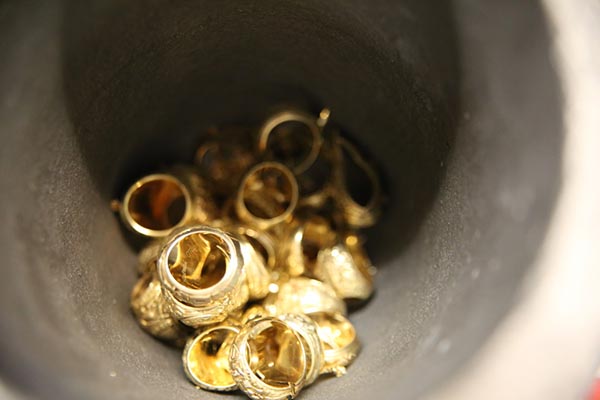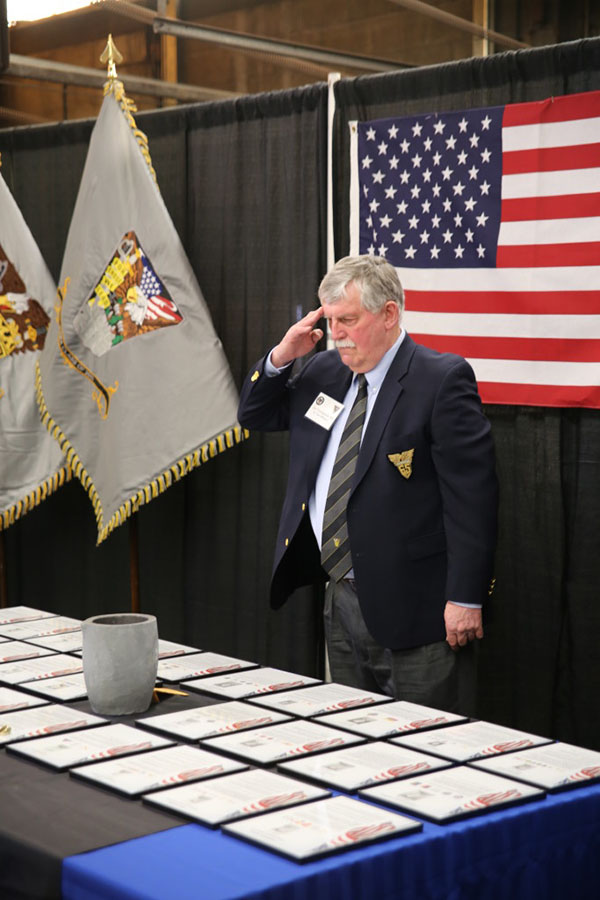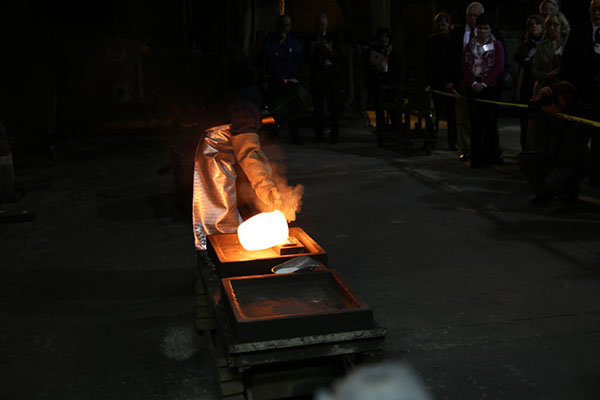In a light-industrial district of Warwick, Rhode Island stands a long low concrete building. It is much like the surrounding buildings, with shipping bays, offices with windows, numerous vents, and a large chimney, but with a more spruced-up presentation than its neighbors and a sign in front discreetly announcing its business: Pease & Curren Refiners. Pease & Curren has served jewelry makers, pawn shops and dental laboratories since 1916. It receives jewelry, plate and scrap from these clients and refines them to extract gold, silver, platinum and palladium.
On February 24, 2014, Pease & Curren provided its refining service in a rather different context, hosting the 14th Annual West Point Class Ring Memorial Melt. Each year since 2000, West Point graduates and the families of deceased graduates have donated the gold rings to be melted down and joined with a gold sample from which future class rings are forged; so far 322 rings have been donated. The industrial process of turning solid gold into liquid and back again is a central part of the ceremony.
We entered the refinery through its offices, were buzzed in and directed to a room in the main plant. Black curtain dividers had been set up to define a room with folding chairs, a podium with an American flag and West Point flag, and a continental breakfast. Behind the curtains we can see tall stacks of boxes labelled Pease & Curren.
About 50 people were in attendance, with several groups dominating: cadets from the class of 2015 (whose rings will contain the gold being melted today), members of the class of 1965 (50 years before 2015) and family members of ring donors. Lying flat on a table in front of the flag were framed biographies of each of the twenty-nine donors, with the donor’s ring at the top left hand corner. In the center of the table stood a grey crucible about ten inches high, a combination of industrial object, tombstone, and reliquary.
After a welcome from Kimberly Michalik, the president of Pease & Curren, the first part of the ceremony begins. Cadets take turns reading biographies of the 29 ring donors (all but three are deceased and the rings were donated by the family). If no family member is present a designated classmate or other academy graduate places the ring in the crucible. He (it is usually a he) salutes the ring and then returns to his seat in silence. It feels solemn each time.

The donated rings in the crucible. Photo courtesy of Anthony DiNoto, West Point Association of Graduates (WPAOG)

Saluting the ring. Photo courtesy of Anthony DiNoto, WPAOG
If family members are present, they kiss the ring (if they are women) or salute it (if they are academy grads). Someone always says a few words, and the moment is poignant for both the families and the rest of the audience. These short addresses bring together themes of body, time, kinship, and gender bound up in this ritual of gold, fire, and human lives. Here are several:
“I believe the ring was his most precious possession. It is that that is going to pass on his legacy.”
“Karl wore that ring day and night.”
“My husband and his friends used to talk about whether to wear their rings into battle, because if they died the ring might be lost. They all decided to wear the rings into battle. “
“As I look at these young faces, I think that even though it is difficult to relinquish something we saw on his hand, we are pleased to pay it forward, to pass his ring on down and let it flow down the long grey line [the continuum of cadets and graduates of the U.S. Military Academy at West Point].”
After the reading of the biographies and placing of the rings, the class president gives a final speech before the melt. He says, “How do we feel about today? Everyone has been looking at the Josten’s catalogue and it’s easy to get caught up in the different jewels, gems and diamonds – how can you have the flashiest ring in the room? But it’s so much more than a piece of jewelry. It is a connection that honors the lives and the stories represented by this ring…. By donating your rings you are gripping hands with our class, we are humbled by your gift. We will never go our separate ways.”
This speech expresses a central insight about forms of wealth, one noted by Jonathan Parry and Maurice Bloch. Some forms of wealth are oriented toward short-term, individual maximization, often emphasizing pleasure and prestige in consumption – how can you have the flashiest ring in the room? Others are oriented to the long-term, collective reproduction of the social order – the bonds between West Point classes and the “lives and stories” of its members. The material substances of the ring express this counterpoint – the cut stone that can be cut further or crushed but can never return to its former shape, and the gold that can be transmogrified into molten gold and back again, or into any new form.

The melted gold is poured into the ingot mold. Photo courtesy of Anthony DiNoto, WPAOG

The cadets deliver the ingot to the Josten’s representative. Photo courtesy of Anthony DiNoto, WPAOG
The cadets bring the crucible to the floor of the refinery and everyone takes photos as the crucible is placed in the forge, which is heated to 2000 degrees. We take a tour of the foundry as the gold melts. During this time, two donors (widows) talk to me and each other about their decision to donate the rings. I ask if their husbands knew about the ring donation program. They didn’t, but both wives are certain they would approve. I ask about the gemstone in the ring, which the donors are asked to remove before donation. One plans to put it in a setting for a pendant; the other likes that idea.
The gold is poured into an ingot mold and cooled in water. It weighs about 23 ounces. Once cooled, it is officially handed over to the Josten’s representative, who will drive it to their factory and add it to the sample from which the next rings are forged. And so on down the long grey line.
As the gold bugs are fond of telling us, “gold never goes away.” It is thus a fitting material to express at once the anguish of personal loss and the comfort of social continuity.
Sources:
Michalik, Kim, March 15, 2010 “The History of the West Point Class Ring Melt”
http://www.peaseandcurren.com/2010/03/the-history-of-the-west-point-class-ring-melt/ (accessed on March 2, 2014).
Bloch, Maurice and Jonathan Parry (1989), “Introduction: Money and the Morality of Exchange.” In Money and the Morality of Exchange, edited by J. Parry and M. Bloch, Cambridge University Press, pp. 1-32.
Photographs by Anthony DiNoto with the West Point Association of Graduates.
Thanks to Alec Spivack for telling me about the West Point Class Ring Melt.

2 Comments
Right now I plan on passing it down to one of my kids. However this article depicts a very real and good option.
I have attended many of the ring melting ceremonies and have been asked, on occasion, to place a ring in the crucible. This has happened when the donor is unable to attend the ceremony and therefore a volunteer provides this service.
The first time I provided this simple service was for the donor of the ring of a 1950 graduate who had died shortly after graduating while serving in Korea (he earned the Silver Star). Following the ceremony I wrote a thank you note to the donor who was the then wife of the graduate. She was, and is, living in Florida and was unable to attend the ceremony.
She followed up with a call to me and told me a little of her life (she had given birth to their son after he had deployed to Korea so he had never seen his child (now deceased), she had remarried another graduate and provided me with other details of her life since the tragic loss of her husband over 50 years previously. She wears the ring’s gemstone as a pendant.
My wife and I and one of my daughters, agreed to meet her and two of her children at West Point – now several years ago. I still stay in touch with her with phone calls and letters and visit the West Point cemetery and her husband’s (and son’s) grave site on my twice yearly visits to West Point.
This ceremony, as meaningful as it is for the donors and, hopefully for the cadets who will be wearing the donated rings, was very, very touching for me.
1 Trackback